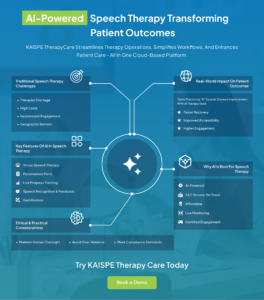The increasing demand for a speech therapy care solution that handles everything in between has proven how essential AI development is in this era. Throughout the years, both patients and therapists have faced countless hurdles.
Not only do people have limited access to qualified therapists, but the high cost of in-person sessions and the hassle of consistent appointments make patient engagement much more of a struggle.
Luckily, with the rise of technology, AI-powered speech therapy care solutions are the present, as it bridges the gap between patient need and the availability of the therapist.
The Challenges in Traditional Speech Therapy
It is important to keep the limitations and challenges of traditional speech therapy in mind when considering virtual speech therapy powered by AI.
1. Limited Availability of Therapists
If we’re talking about the limitation, according to the ASHA SLP Health Care Survey, almost half of the healthcare facilities reported having empty speech therapist seats. This clearly shows the shortage of these specialists which results in delayed treatment and longer waiting lists. The situation is worse in rural areas.
2. High Cost of In-Person Sessions
Since speech therapy sessions require consistency, such regular in-person sessions can be expensive for many families. The entire commute cost and repeated sessions can be a financial burden for many people.
3. Inconsistent Patient Engagement
Another limitation of traditional speech therapy is the inconsistency in patient engagement due to 1-2 weekly sessions. This sometimes turns out to be a barrier to proper guidance and patient performance review.
4. Geographic Barriers
Many people are often limited to visiting their local speech therapist because of the travel. Travel can be the biggest barrier to accessing the care they need if they have mobility issues.
What Is An AI-Powered Speech Therapy Care Solution?
An AI-powered speech therapy care solution is a digital platform that uses artificial intelligence to support and upgrade the work of speech therapists. Unlike typical sayings, it doesn’t replace human professionals. In fact, it helps them cater to their patients better by lending them a helping hand.
One of the best examples of a speech therapy care solution powered by AI is the KAISPE TherapyCare app. It is a cloud-based solution that acts as a central hub for patient engagement, and it handles all the administrative work for the SLP as well.
Key Features Of AI In Speech Therapy
Some of the most important features of AI in speech therapy that can be found in many speech rehabilitation software programs, the following are mentioned below:
1. Virtual Speech Therapy Sessions
You can connect with your therapist from anywhere in the world with real-time telehealth sessions . This takes away the barrier of distance and time.
2. Personalized Treatment Plans
Digital speech therapy tools offer valuable insights into patient data. This includes patient progress and history, which helps the speech therapists tailor the plans according to the client’s specific needs.
3. Real-Time Progress Tracking
Instead of the traditional note-taking, which can be limited in terms of frequent updates, an AI-powered speech therapy care solution like KAISPE TherapyCare app can provide real-time progress tracking.
4. Speech Recognition & Feedback Algorithms
One of the most important and crucial things that makes speech rehabilitation software better than traditional methods is the speech recognition. The advanced algorithms provide feedback on fluency and pronunciation by analyzing the patient’s speech. The best part is that patients can use it to practice creating new habits that help in improvement.
Real-World Impact: How AI Improves Patient Outcomes
Apart from the management ease and administrative automation, AI in speech therapy can change patient outcomes and provide better results.
1. Faster Recovery Rates
With real-time feedback and better practice, patients can learn better speech than the previous traditional methods.
2. Improved Accessibility
It provides better accessibility to both patients and the speech therapists since it eliminates the barriers of distance.
3. Gamification
The best way to get children to do speech therapy and practise it more often is with fun games and rewards. These happy games make speech therapy more engaging and productive.
4. Case Studies
In a case study where children aged from 10-19 who couldn’t pronounce the letter “r” properly, a virtual speech therapy tool was used for practice. The results proved that AI provides the necessary repetitive practice that is otherwise difficult.

Comparing AI vs. Traditional Speech Therapy
The best way to have an overview of both traditional and an AI-powered speech therapy care solution is to discuss the pros and cons of each:
AI-Powered Speech Therapy
Pros
- Tools Available 24/7 with no travel needed.
- More affordable compared to in-person sessions.
- Real-time monitoring of progress available
- Gamification features for kids for excitement and engagement
Cons
- Cannot replicate a therapist’s non-verbal cues.
- Need a reliable internet connection and device.
- Requires strict data privacy and security.
Traditional Speech Therapy
Pros
- Offers more social interaction, which is empathetic
- A therapist can handle complex and nuanced cases.
- Can adjust sessions based on a patient’s real-time emotional state.
Cons
- Limited by location and the therapist’s schedule
- Can be very expensive without insurance coverage.
- Difficult for patients to do continuous practice between sessions.
How To Get Started With An AI Speech Therapy Care Solution
If you’re interested in improving your practice with speech rehabilitation software, here are the steps you need to take to make the best choice:
1. Choosing The Right Platform
The most important thing to look for when you’re opting to shift to AI-powered tools is to choose the right platform. Look for a speech therapy care solution that aligns with your practice’s needs and helps you to make your practice more effective. You should consider features like security and ease of use.
Out of all the other options, KAISPE TherapyCare app is a great example of a solution designed to streamline the entire practice.
2. Integration With Existing Healthcare Systems
Many platforms are built to integrate seamlessly with existing electronic health records, and it’s better to choose a platform like that for a smooth transition of data.
3. Ensuring Data Privacy and Security
Compliance with healthcare regulations is something that cannot be ignored. Make sure that the speech therapy care solution prioritizes data security and privacy.
Ethical & Practical Considerations
There has been a lot of buzz around ethical AI applications, and here are some things you can do to ensure that no risk is posed:
1. Maintaining Human Oversight
Since healthcare is more critical, it is necessary that the AI tools are supervised by humans.
2. Avoiding Over-Reliance on Technology
Technology can help the human connection to evolve. However, it cannot replicate it. It should be used to support the patient-therapy relationship.
3. Meeting Medical Compliance Standards
It should follow the rules and regulations of data privacy and security. This ensures proper patient safety.
Conclusion
When we talk about the future of speech therapy, it is a collaborative one where there is human expertise and intelligent technology working together. Solutions like the KAISPE TherapyCare app clearly demonstrate the potential of AI in speech therapy to help therapists and improve patient outcomes.




